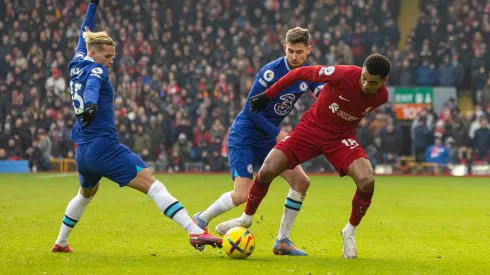After the January transfer window closed on Tuesday, football executives throughout Europe took a deep breath. The amount of money spent in January alone was staggering. More than one billion dollars. However, the most eye-popping metric was that one single Premier League club spent more on January transfers than every single club in the Bundesliga, LaLiga, Serie A and Ligue 1 combined.
It wasn’t just Chelsea who were on a spending spree. In fact, the Premier League accounted for over 85% of total spending from Europe’s top five leagues. Moreover, four Premier League clubs in relegation trouble near the bottom half of the table (Southampton, Bournemouth, Wolverhampton Wanderers and Leeds United) all spent around, or more than, $50 million each in this window.
The spending of the Premier League in January highlights the discrepancy between the purchasing power of England’s top flight versus its counterparts in Spain, France, Italy and Germany.
Call back to the uprising against the European Super League. Fans wanted to see the best clubs and best players fighting for a spot in elite competitions. Fans did not want to see teams buy their way to success and have no threat of missing out.
The Premier League is in a state of hopeful buying to get success, embodying the Super League in the sense that it is a competition built on the backs of money. Only all that money goes to transfers.
The top talents
The Premier League is already the most popular domestic league in Europe for worldwide fans. The history of many of the clubs is enough to draw attention. However, the arrival of elite players for clubs from the top to the bottom adds fuel to a fire that is burning the other leagues in Europe.
As more players join the league, there is more incentive to watch. Consequently, fans lose interest in other leagues in Europe. For example, Joao Felix left Atletico Madrid on a loan deal. That takes away one of LaLiga’s more creative and entertaining players in a top side. Mykhailo Mudryk lit up the Champions League with Shakhtar Donetsk, and he will not be there for the club’s Europa League run. Enzo Fernandez emerged on to the scene with Argentina at the World Cup, making Chelsea draw him away from Benfica. To be fair, Fernandez is not the first major move away from Benfica in recent years.
Then, young players with abounding talent are now joining the Premier League. PSV talents Cody Gakpo and Noni Madueke made big money moves to England. Benoit Badiashile and Malo Gusto had price tags over $30 million.
At the center of this spending that is setting the Premier League apart is Chelsea. Chelsea’s casual spending of $360 million is almost $100 million more than the other top four leagues combined. Ligue Un, the Bundesliga, LaLiga and Serie A combined for just shy of $285 million. Reminder, this is just the January transfer window.
LaLiga voiced against this insatiable spending in the Premier League, calling it a form of ‘cheating’ against the rest of Europe. LaLiga president Javier Tebas shared a video on his Twitter of corporate general director Javier Gomez. In the video, Gomez breaks down his issues.
“Essentially, they are ‘doping’ the club. They are injecting money not generated by the club for it to spend, which puts the viability of the club at risk if the shareholder leaves.”
Think about Todd Boehly leaving Chelsea and how that would impact the club’s ability to spend on transfers.
“In our opinion, that is cheating, because it drags down the rest of the leagues,” Gomez finished.
Premier League reformation of a super league
While it is easy to point fingers and say Chelsea is the cause for these record figures in the Premier League, that is not necessarily the case. Spending was bountiful across the league. Interestingly, it was not from the other clubs that tend to spend freely. The two Manchester clubs combined to spend just $15 million on a total of four new players. Tottenham only loaned in two players for $10 million. Liverpool issued $45 million to PSV for Cody Gakpo, but that was its only spending. Even Arsenal, which was under pressure to make moves to push for a Premier League title, spent less than a fifth of Chelsea. The Gunners still paid a total of $65 million for three players, but two of those came from Premier League rivals, Brighton and the aforementioned Chelsea.
Instead, look at clubs with a smaller budget that are making moves. Of course, it is necessary for them to reach deeper into the pocket just to keep up with a club like Chelsea under billionaire ownership.
Southampton, the club at the bottom of the Premier League table, spent the second most of any team in the top flight. Kamldeen Sulemana’s price tag of $27 million is a club-record fee for the Saints. Leeds also set a club record fee when it dropped $37.5 million on forward Georginio Rutter. This is the difference. When clubs at the bottom of the table are breaking the bank on players just to stay afloat, it shows the competitive nature of the Premier League.
Competing with other leagues
What stands out for many of these bottom-half teams is how they competed with elites in the lore of soccer for players. The most storied topic was Nicolo Zaniolo, a midfielder or forward for Roma who fell out of favor with Jose Mourinho and the fans. Zaniolo declared his intent to move as Milan and Spurs showed interest. However, the only club to offer something to Zaniolo was Bournemouth.
After Milan never made up the funds or overt desire to sign Zaniolo, the Italian defected to his second option in Bournemouth. However, by that time, the Cherries already spent money on replacements. AFCB, a club in the relegation scrap, denied the right back for Roma.
If anything, that shows where the Premier League is at based on intent to sign. Relegation sides in the Premier League are competing with clubs that declared to join the European Super League. Bournemouth is targeting players with 11 starts for a team competing for a Champions League spot in Serie A. That potential deal for Zaniolo was likely a loan, but his market value is somewhere in the $30 to $40 million range.
If Bournemouth is ready to splash on transfers when top Serie A clubs are more conservative, the game can only grow around the Premier League.
The future of transfers
There is certainly an argument to be made that this season is an anomaly. LaLiga’s limits on player transfers with a salary cap hinder its ability to draw in headline fees. Serie A’s top clubs are under the microscope right now due to fudging the numbers. After all, Juventus looks set to miss out on European competition next season due to a points deduction stemming from “financial irregularities” regarding historic transfers.
The Bundesliga, even its top clubs, are historically frugal. That is not necessarily a talent issue, though. Bayern secured Joao Cancelo on loan from Manchester City, despite the Portuguese remaining a top talent. However, you do not see Schalke, Hertha Berlin and Bochum spending rapidly to get out of the relegation zone. In fact, those clubs spent just $1.5 million combined, including loan deals.
The consequence of this is more Premier League growth. In terms of players, the top clubs will only seek the best. That includes young talents like Mudryk and Fernandez and proven players. More eyes watch these players, because clearly that is the best of the best.
For instance, think back to that Benfica graphic on its most expensive departures. They all cost more than $37 million. Eight of those 10 will be in the Premier League for the back half of the 2022/23 season, even if that is not where they went right away.
This will spiral into the Premier League increasing its power. As a result, the Premier League evolves into the Super League.
PHOTO: IMAGO / Propaganda Photo















